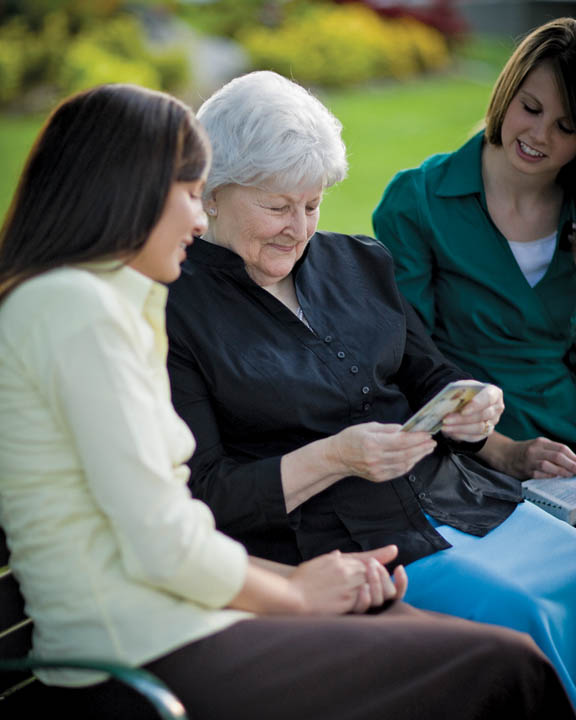 In weekly worship services and classes, Mormon women preach sermons, offer prayers in behalf of the congregation, and teach adults and children. They may also serve as missionaries and as presidents of the Relief Society, Young Women, and Primary organizations. Mormon women participate in councils that oversee congregational activities throughout the world. They also perform a vital work in nurturing and teaching in the home.
In weekly worship services and classes, Mormon women preach sermons, offer prayers in behalf of the congregation, and teach adults and children. They may also serve as missionaries and as presidents of the Relief Society, Young Women, and Primary organizations. Mormon women participate in councils that oversee congregational activities throughout the world. They also perform a vital work in nurturing and teaching in the home.
Every willing member of the Church has many opportunities to render service, share talents, and gain new skills. Every week, Mormon women preach, teach, and lead in the Church on local and worldwide levels.
In addition, women in The Church of Jesus Christ of Latter-day Saints belong to and lead the Relief Society, an organization of several million women worldwide. Mormon women also lead the Church’s Young Women organization and the Primary, an organization for teaching children. The leaders of these organizations meet regularly in executive councils to help make decisions that affect the worldwide Church. These organizations also exist on the local level, with women participating in council meetings to discuss and direct the work of the Church in local units.
A woman—the president of the Relief Society in each congregation—has a special role in working with the congregational leader, or bishop, to meet the needs of members who may struggle financially or who may face other special challenges in their lives.
The priesthood—the authority of God to perform ordinances and act in His name—is conferred only on worthy male members of the Church. Men who hold the priesthood have no advantage over women in qualifying for salvation or eternal life through the Atonement of Jesus Christ. [1]
Relief Society
The main organization for women in the Church is the Relief Society, which was founded in 1842. Today the organization includes more than 5.5 million women ages 18 and older in over 170 countries. Every Sunday the Relief Society holds a one-hour meeting for women as a part of regular Sunday services. The meeting provides religious instruction and helps women teach the gospel of Jesus Christ to their families in their own homes.
 Members of Relief Society also help those in need by providing meals, clothing and other necessities. Relief Society members also participate in projects for the Humanitarian Aid program of the Church, assembling hygiene kits, sewing quilts, making toys and clothing and picture books, and assembling educational packets. In addition, women participate in a literacy program to help others learn reading and writing skills. The Relief Society has a unique program called “visiting teaching” to provide a support network for women in the Church. Each woman is assigned two other women who visit her home each month to give a religious message and offer help if needed.
Members of Relief Society also help those in need by providing meals, clothing and other necessities. Relief Society members also participate in projects for the Humanitarian Aid program of the Church, assembling hygiene kits, sewing quilts, making toys and clothing and picture books, and assembling educational packets. In addition, women participate in a literacy program to help others learn reading and writing skills. The Relief Society has a unique program called “visiting teaching” to provide a support network for women in the Church. Each woman is assigned two other women who visit her home each month to give a religious message and offer help if needed.
“Home, family, and personal enrichment meetings” also provide opportunities for Mormon women to meet together outside of Sunday meetings and participate in activities such as book clubs, classes on parenting and homemaking skills, service projects, and social events.
Roles and attitudes of Mormon Women
- Men and women are expected to be equal partners in the home. Although men preside in the home, as they hold the priesthood and follow a patriarchal order, men are not to excercise any form of coercion. Physical or emotional abuse can result in excommunication. Former Prophet Gordon B. Hinckley stated, “In this Church the man neither walks ahead of his wife nor behind his wife but at her side. They are co-equals in this life in a great enterprise.” President Spencer W. Kimball said, “We have heard of men who have said to their wives, ‘I hold the priesthood and you’ve got to do what I say.’ ” He decisively rejected that abuse of priesthood authority in a marriage, declaring that such a man “should not be honored in his priesthood.” He also said, “When we speak of marriage as a partnership, let us speak of marriage as a full partnership. We do not want our LDS women to be silent partners or limited partners in that eternal assignment! Please be a contributing and full partner” (The Teachings of Spencer W. Kimball, ed. Edward L. Kimball [1982], 315, 316).
- Women are not expected to have a large number of children. Mormons use birth control. The number of children welcomed into the household is to be a subject of prayer, and a decision to be made by husband, wife, and the Lord. However, Mormons have large families compared to other groups in nearly every country where they reside. This is a result of the emphasis on family life, and a knowledge of the Plan of Salvation.
- Mormon women are encouraged to be “stay-at-home moms.” Though a large number of Mormon women work outside the home, they are encouraged to do so only out of necessity, or after their children are grown. Mormon women are counseled not to work in order to provide luxuries for the family. Quantity time is emphasized in the family, and the mother’s role in the home is too important to be relegated to a lower priority than vocational goals.
- Women in the Church are counseled to become educated. Mormon women are generally well-educated, due to the emphasis that the Church places on education.
-
Women in the Church dress according to the fashions of the day, with an emphasis on modesty.
Why don’t Mormon women hold the Priesthood?
Mormon Apostle Dallin H. Oaks said this about the matter:
- President [Joseph Fielding] Smith explained: “While the sisters have not been given the Priesthood, . . . that does not mean that the Lord has not given unto them authority. Authority and Priesthood are two different things. A person may have authority given to him, or a sister to her, to do certain things in the Church that are binding and absolutely necessary for our salvation, such as the work that our sisters do in the House of the Lord” (Relief Society Magazine, Jan. 1959, p. 4).
- President Smith’s teaching on authority explains what the Prophet Joseph Smith meant when he said that he organized the Relief Society “under the priesthood after the pattern of the priesthood.” The authority to be exercised by the officers and teachers of the Relief Society, as with the other auxiliary organizations, was the authority that would flow to them through their organizational connection with The Church of Jesus Christ of Latter-day Saints and through their individual setting apart under the hands of the priesthood leaders by whom they were called (“The Relief Society and the Church,” Ensign, May 1992, 34).
Mormons believe there are fundamental, divine differences between men and women and that women do not require ordination to the priesthood to perform their responsibilities in the Church or their families. Men and women have different, though equally essential roles, both in the family and in Church leadership. [2]
Other interesting articles: Happiness in Womanhood, The Blessings and Responsibilities of Womanhood, Women of Righteousness, The Relief Society and the Church
